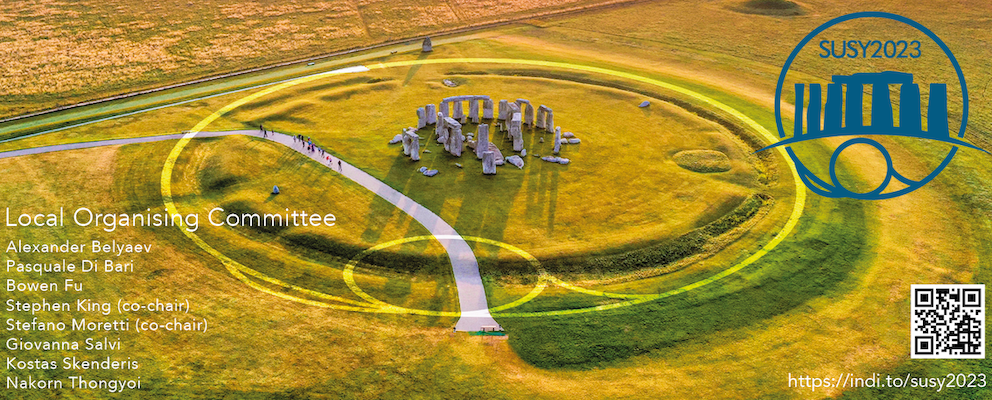Model building based on string compactifications faces difficult challenges: moduli can be tricky to stabilize, scales to separate, dark energies to uplift and supersymmetry to break in a controlled fashion. String theories where the latter is broken at the string scale can offer different corners of the landscape to explore, with different pros and cons. I will describe how the instabilities...
I will discuss some theoretical and phenomenological implications of a string theory-inspired, cosmological phase of kination, dominated by the kinetic energy of a rapidly rolling scalar. In the first part of the talk, I will argue how such a kination epoch can naturally arise in string compactifications after inflation, focusing on the case where it is driven by the volume modulus. I will...
In our study, we explore the influence of catalysis on the vacuum decay within the framework of type IIB string theory. This decay process involves the creation of a bubble that combines with an impurity, effectively acting as a catalyst. Although we show the 1-loop analysis at first, to calculate the life-time more accurately, we take use of variational perturbation method and go beyond the...
We present the full Lagrangian and local supersymmetry transformation rules for the gauged D=4, N=4 (half-maximal) supergravity coupled to an arbitrary number of vector multiplets. Using the embedding tensor formulation, the final results are universal and valid in an arbitrary symplectic frame. We also derive the conditions satisfied by the critical points of the scalar potential and we...
Early Dark Energy (EDE) is a promising model to resolve the Hubble Tension, that, informed by Cosmic Microwave Background data, features a generalization of the potential energy usually associated with axion-like particles. We develop realizations of EDE in type IIB string theory with the EDE field identified as either a $C_4$ or $C_2$ axion and
with full closed string moduli stabilization...
RG-induced moduli stabilisation was recently proposed as a new mechanism that adapts to string theory a perturbative method for stabilising moduli without leaving the domain of perturbative control and without the inclusion of non-perturbative effects. In this talk, we briefly revise the necessary ingredients in the construction of this mechanism. In addition, we examine the cosmological...
We study the inflection point inflation generated by polynomial superpotential and canonical K\"ahler potential under the supergravity framework, where only one chiral superfield is needed. We find the special form of the scalar potential limits the possible Hubble value up to $\mathcal{O}(10^{10}) \, \textrm{GeV}$ and the inflaton mass to $\mathcal{O}(10^{11}) \, \textrm{GeV}$. We obtained...
We investigate the formation of composite states of the goldstino in theories with non-linearly realized supersymmetry and show that the Volkov-Akulov model has an instability towards goldstino condensation. We discuss the implications of our findings for string models involving anti-brane uplifts.
Cosmologically plausible compactification scenarios typically require parametric separation between the cosmological and the compactification length scales.
When the higher-dimensional solution is in the semi-classical regime, the full quantum-corrected equations of motion are naturally expanded in the local values of various fields. In this talk, we will present constraints on AdS...
Obtaining genuine lower-dimensional theories from string theory remains a real challenge.
This can be done if the Kaluza-Klein energy scale can be made much larger than the cosmological constant.
In this talk, I review the situation for minimally supersymmetric models in type IIA string theory. There the separation of scales is achieved due to unbounded flux quanta that can be send to...
The existence of AdS vacua in string theory with a parametric separation between the Hubble
scale and the Kaluza-Klein scale of the extra dimensions is an open question, and holography is a
promising tool to tackle this. I will discuss some remarkable holographic features
of the DGKT vacua, which are candidate AdS vacua with parametric scale separation.
The absence of supersymmetry in string theory usually leads to runaways, arising from nonvanishing dilaton tadpoles. The spacetime manifestation is a scalar potential, which might be a blessing in disguise for flux compactifications, even though it typically brings along singularities or instabilities.
In this talk, I will discuss a first-order formalism, already known in its most basic form...
Using interaction rates computed to second order in string perturbation theory, we pose a system of Boltzmann equations describing an ensemble of long open and closed strings in different regimes (which include high and low density of D-branes), for an arbitrary number of "effectively non-compact" directions, along which strings cannot wind. We find equilibrium distributions for all these...
No-Scale SUGRA has attracted considerable interest as a framework for inflation as it provides a natural realisation of Starobinsky-like inflation models. Recently, it was shown that suitable modifications of the Kahler potential produce a kink on the inflaton scalar potential that generates an enhancement in the power spectrum, leading to the production of Gravitational Waves. In this talk,...
"Shi-Fuller mechanism" is known as one of the scenarios which can explain all dark matter by sterile neutrinos not conflicting with any other current observational constraints. We revisit the numerical calculation of final energy spectrum of sterile neutrinos for given initial lepton asymmetry in Shi-Fuller mechanism by properly incorporating the effects of neutrino oscillation in active...
The aim of this paper is to highlight the challenges and potential gains surrounding a coherent description of physics from the high-energy scales of inflation down to the lower energy scales probed in particle-physics experiments. As an example, we revisit the way inflation can be realised within an effective Minimal Supersymmetric Standard Model (eMSSM), in which the LLe and udd flat...
Using effective operators, we propose models in which the sgoldstino is
stabilized close to the origin to reproduce the nilpotent constraint. We show that small sgoldstino fluctuations may lead to a sizeable backreaction on the cosmological history. We study the effect of this back-reaction on the inflation observables measured in the cosmic microwave background and confront the model to a...

